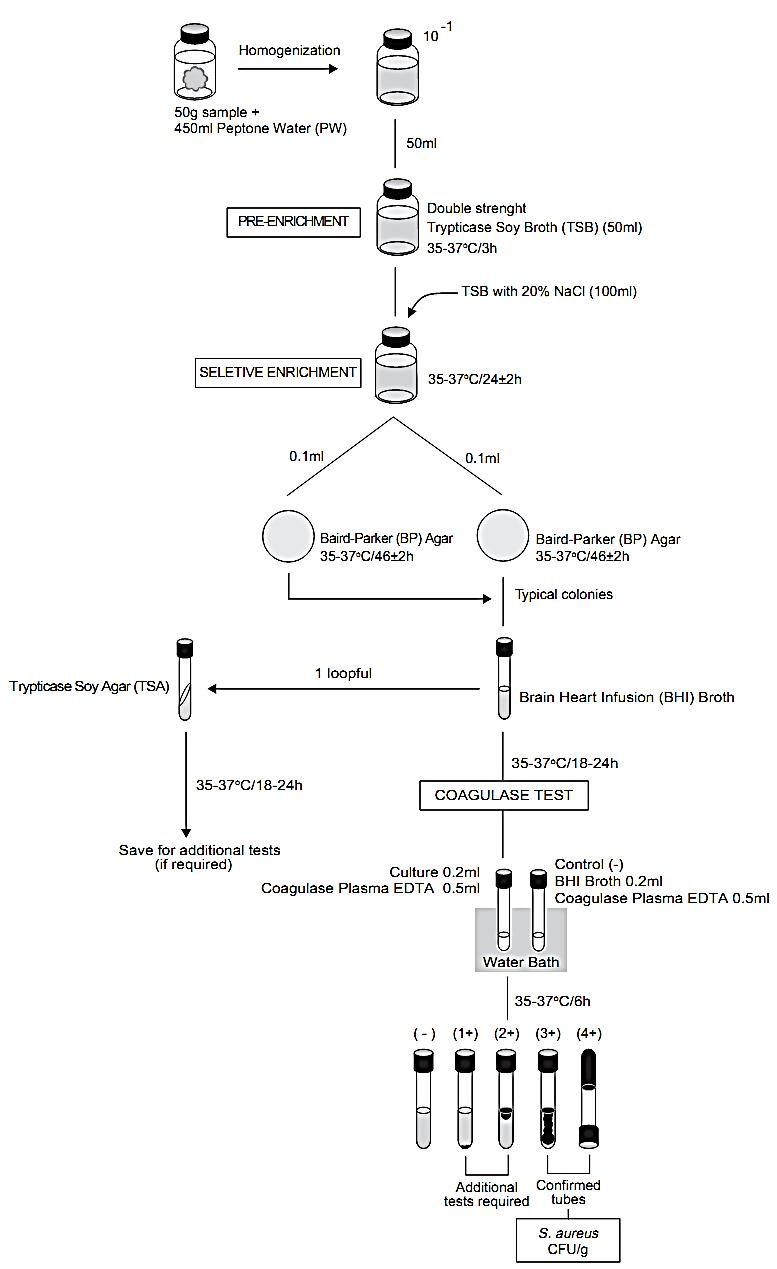


 النبات
النبات
 الحيوان
الحيوان
 الأحياء المجهرية
الأحياء المجهرية
 علم الأمراض
علم الأمراض
 التقانة الإحيائية
التقانة الإحيائية
 التقنية الحيوية المكروبية
التقنية الحيوية المكروبية
 التقنية الحياتية النانوية
التقنية الحياتية النانوية
 علم الأجنة
علم الأجنة
 الأحياء الجزيئي
الأحياء الجزيئي
 علم وظائف الأعضاء
علم وظائف الأعضاء
 الغدد
الغدد
 المضادات الحيوية
المضادات الحيوية| Presence/absence method for coagulase positive staphylococci and S. aureus in foods |
|
|
|
Read More
Date: 21-3-2016
Date: 21-3-2016
Date: 9-3-2016
|
Presence/absence method for coagulase positive staphylococci and S. aureus in foods
Method of the American Public Health Association (APHA), as described in the 4th Edition of the Compendium of Methods for the Microbiological Examination of Foods (Lancette & Bennett, 2001).
This method is recommended for processed foods likely to contain a small population of injured cells.
1 - Material required for analysis
Preparation of the sample and serial dilutions
• Diluent: 0.1% Peptone Water (PW) or Butterfield’s
Phosphate Buffer
Presence/absence test
• Double strength Trypticase Soy Broth (TSB) (50 ml flasks)
• Single strength Trypticase Soy Broth (TSB) with 20% NaCl (100 ml flasks)
• Baird Parker (BP) Agar plates
• Laboratory incubator set to 35–37°C
Confirmation
• The same material required as for the plate count method APHA 2001
2 - Procedure
A general flowchart for the determination of S. aureus by the APHA presence/absence method is shown in Figure 1.
a) Pre-enrichment. homogenize 50 ml of the sample with 450 ml of Peptone Water (PW) (10−1 dilution).
Transfer 50 ml of the 10−1 dilution (5 g of sample) into 50 ml of double strength Trypticase Soy Broth (TSB). Incubate at 35–37°C/3 h.
Note a.1) To increase the detection limits an analytical unit of 100 g (in 900 ml of diluent) may be used. For liquid samples it is not necessary to dilute.
b) Selective enrichment. After the 3 h incubation period, add 100 ml of single strength Trypticase Soy Broth (TSB) with 20% NaCl to the pre-enriched sample. Incubate at 35–37°C/24 ± 2 h.
c) Confirmation. Inoculate two 0.1 ml portions of the selective enrichment broth onto duplicate plates of Baird-Parker (BP) Agar (spread plate).
Incubate plates at 35–37°C/46 ± 2 h and examine for typical colonies.
From each plate showing growth, select at least one presumptive colony and confirm . Report results as S. aureus presence or absence in 5 g of food.

Figure 1 Scheme of analysis for the detection of coagulase positive staphylococci and Staphylococus aureus in foods using the presence/absence method APHA 2001 (Lancette & Bennett, 2001).
References
Silva, N.D .; Taniwaki, M.H. ; Junqueira, V.C.A.; Silveira, N.F.A. , Nasdcimento , M.D.D. and Gomes ,R.A.R .(2013) . Microbiological examination methods of food and water a laboratory Manual. Institute of Food Technology – ITAL, Campinas, SP, Brazil .
Lancette, G.A. & Bennett, R.W. (2001) Staphylococcus aureus and staphylococcal enterotoxins. In: Downes, F.P. & Ito, K. (eds). Compendium of Methods for the Microbiological Examination of Foods. 4th edition. Washington, American Public Health Associa-tion. Chapter 39, pp. 387–403.



|
|
|
|
تفوقت في الاختبار على الجميع.. فاكهة "خارقة" في عالم التغذية
|
|
|
|
|
|
|
أمين عام أوبك: النفط الخام والغاز الطبيعي "هبة من الله"
|
|
|
|
|
|
|
المجمع العلمي ينظّم ندوة حوارية حول مفهوم العولمة الرقمية في بابل
|
|
|